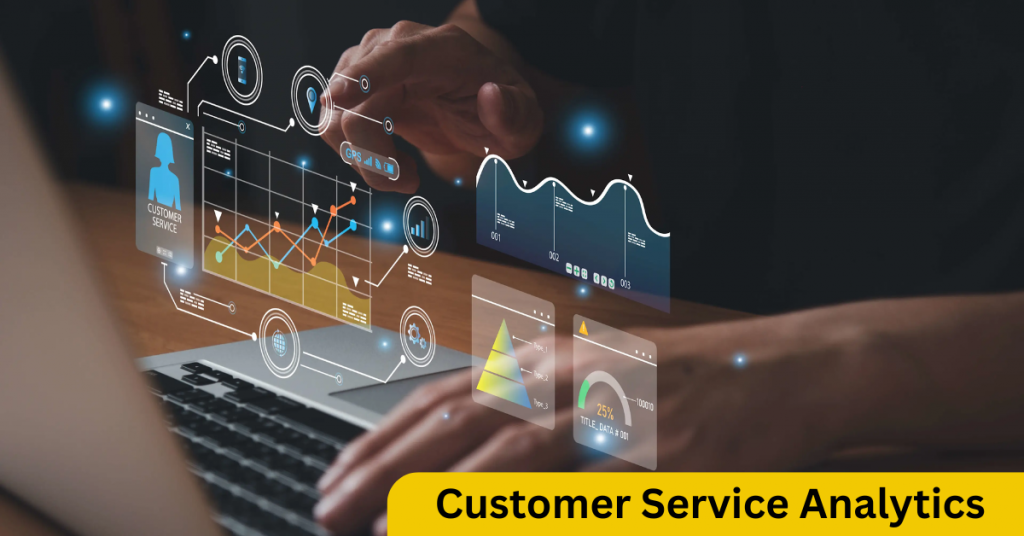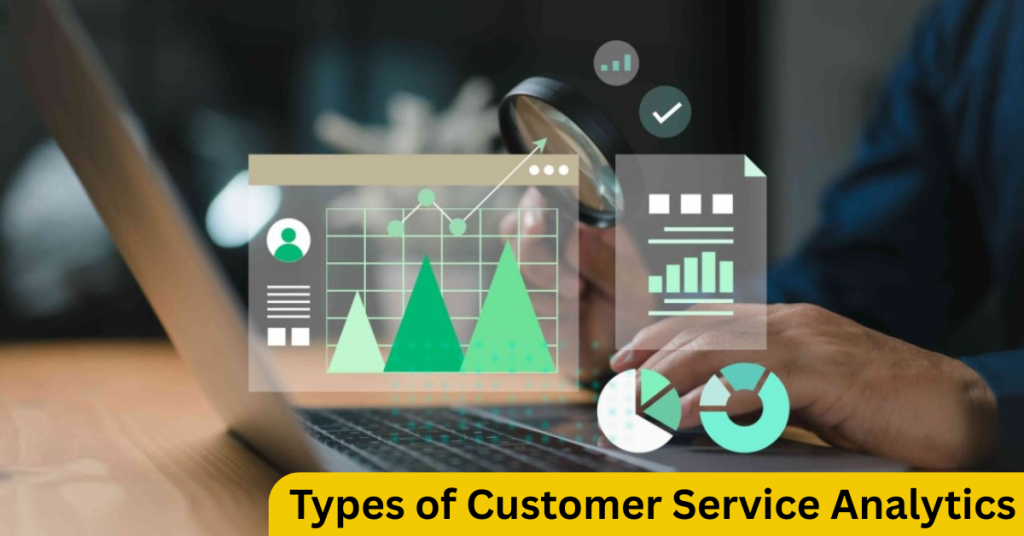According to recent studies 93% of customers are inclined to make repeat purchases from businesses that provide exceptional customer service. As customer expectations change, companies need to adjust to accommodate these needs, and one of the best means of doing so is through data-driven customer service. In the past decade, data has revolutionized the way businesses interact with customers, providing valuable insights into customer behavior, likes, and dislikes. Customer Service Analytics has become an essential tool for organizations seeking to improve their customer care and establish enduring relationships.
The conventional customer service method of relying on anecdotal experience or after-the-fact actions is rapidly being displaced by more advanced, data-based methodologies. Customer service analytics takes massive sets of data—collected from support requests, chat histories, surveys, and feedback forms—used to make decisions and craft uninterrupted experiences for customers.
In this blog post, we’ll explore what customer service analytics is, its types, key use cases, and the tangible benefits it brings to businesses. We’ll also cover essential metrics that every business should track, and how A3Logics, with its advanced data analytics services, helps organizations leverage customer service analytics to make smarter decisions.
Table of Contents
What is Customer Service Analytics?

Customer service analytics refers to the practice of collecting and evaluating data from customers. Data is collected from all stages of the consumer relationship, including messages, purchases, survey comments, returns, and demographics. Companies frequently employ analytics solutions to collect client data from all areas of the organization in order to provide important insights.
Ideally, these insights will guide marketing, product development, and the overall customer experience.
According to a recent research, 74% of customers are devoted to a specific brand or company. Customer loyalty influences retention, and there is a direct correlation between loyalty, retention, and minimal customer effort. Customer effort, often known as a Customer Effort Score, indicates how much effort a customer makes in assistance scenarios.
The scope of customer service analytics includes tracking interactions across various touchpoints—support tickets, live chat, phone calls, emails, and even social media channels. It allows businesses to track the effectiveness of their support agents, understand customer sentiment, identify recurring issues, and make data-backed decisions to enhance the customer experience.
> Data Sources Used in Customer Service Analytics
To generate actionable insights, customer service analytics relies on several data sources, including:
- Support Tickets: Detailed records of customer queries, issues, and resolutions.
- Chat Logs: Transcripts of live chats between customers and agents, offering a granular look into customer concerns.
- Feedback Forms: Customer satisfaction surveys filled out after each interaction.
- Surveys: More extensive feedback tools used to assess overall service quality.
- Social Media: Insights from platforms like Twitter, Facebook, and LinkedIn can provide valuable information on customer sentiment.
> Traditional Support vs. Data-Driven Support
Traditional customer service often relied on reactive measures. When a customer raised an issue, the support team would address it without proactively analyzing the problem in-depth. Data-driven support, on the other hand, uses insights from customer data to anticipate issues before they arise, personalize solutions, and even predict future trends.
Why is Customer Service Analytics Important for Businesses?

Incorporating customer service analytics into your operations is no longer optional—it’s essential for staying competitive. Here are the benefits of Customer Service Analytics that can significantly impact businesses:
1. Improving Customer Experience (CX)
Benefits of Customer Service Analytics includes providing businesses with a deep understanding of their customers’ behaviors and pain points. By examining data, businesses can tailor their support strategies, ensuring that customers receive quicker, more relevant responses. This helps create a positive CX, which directly correlates to customer satisfaction and loyalty.
2. Impact on Retention and Loyalty
Customer service is a key factor in retaining customers. Analytics allows businesses to identify opportunities for improvement, whether it’s reducing wait times, addressing common complaints, or improving agent performance. By continuously enhancing the service experience, businesses can foster customer loyalty and increase retention rates.
3. Operational Efficiency
Analytics can uncover inefficiencies within customer service processes. For instance, it can identify bottlenecks in response times, issues with ticket routing, or areas where automation can streamline operations. This leads to improved productivity, reduced costs, and better use of resources.
4. Proactive Support
Rather than waiting for customers to report issues, businesses can use predictive analytics to anticipate problems before they arise. By analyzing historical data, businesses can detect patterns and potential service disruptions, allowing them to resolve issues proactively and minimize negative customer experiences.
Types of Customer Service Analytics

Customer service analytics is multifaceted and includes several types of analytics. Let’s take a closer look at each one:
1. Descriptive Analytics
Descriptive analytics in customer service is focused on understanding historical data. It helps businesses answer the question, “What happened?” For example, businesses might use descriptive analytics to track the number of customer inquiries or complaints over a specific period, or to assess customer satisfaction based on survey responses.
Descriptive analytics in customer service lays the groundwork for deeper insights by identifying trends and patterns in past behavior.
2. Diagnostic Analytics
Diagnostic analytics goes beyond merely describing what happened. It helps businesses understand why something happened. For instance, if customer satisfaction dropped, diagnostic analytics can help determine the root cause—whether it’s slow response times, unresolved issues, or poor service from agents. This insight enables businesses to address specific pain points that might not be immediately obvious through descriptive analytics alone.
3. Predictive Analytics
Predictive analytics uses historical data and statistical algorithms to predict future outcomes. It’s about answering the question, “What could happen next?” By analyzing past trends and behaviors, businesses can forecast potential customer issues, such as which customers are likely to churn or which products may need additional support. Predictive analytics can help companies anticipate demand, optimize staffing levels, and improve service delivery.
4. Prescriptive Analytics
Prescriptive analytics use cases in customer services goes a step further by providing recommendations on how to handle future scenarios. It uses data to suggest the best course of action for improving customer service. For example, if one of the prescriptive analytics use cases shows that a certain issue is likely to arise, prescriptive analytics can recommend specific steps to mitigate the impact, such as preemptively training agents on that topic or deploying additional resources.
5. Customer Journey Analytics
This type of analytics focuses on the customer’s entire journey, from their first touchpoint with the company to post-purchase interactions. By analyzing the complete journey, businesses can identify moments of friction and opportunities for improvement. Customer journey analytics helps optimize the entire customer lifecycle and ensures that customers receive a seamless experience at every touchpoint.
6. Customer Experience Analytics
Customer experience analytics can be used to increase revenue. CX analytics are a type of descriptive analytics that investigates “what happened” during the customer journey. These are the “standard” kind of customer analytics: they summarize raw data into something that is easy to grasp and communicate.
To improve existing operations, important performance measures such as customer satisfaction (CSAT), first response time (FRT), and total time to resolution (TTR) can be extracted and viewed from support data. CSAT can help support agents measure their performance while also assisting professionals throughout the organization, from product and marketing to sales, in identifying areas for improvement.
These insights can help shape tactics for the next time the incidents occur. The data can also provide a story about how a support organization operates, allowing for optimal customer support or departmental planning.
7. Customer Retention Analytics
Customer effort, often known as a Customer Effort Score, indicates how much effort a customer makes in assistance scenarios. The rationale here is simple. High customer effort leads to a poor customer experience. Bad experiences decrease client loyalty and increase churn. Churn isn’t cool.
Analyzing client retention can help businesses enhance ads, products, and support. Customer retention analytics may help you upsell and cross-sell to your existing customers, which is significantly easier and more profitable than acquiring new consumers.
Aside from the Customer Effort Score, other helpful customer retention indicators include the Customer Churn Rate (CCR), in which customers lost are split by customers from the start. Customer Lifetime Value (CLV) predicts the customer’s value in comparison to other measures, whereas Loyal Customer Rate (LCR) indicates which consumers are likely to stick around and refer your brand or product to others.

Customer Service Analytics Use Cases
The applications of customer service analytics are vast. Here are a few key use cases of Customer Service Analytics:
1. Analyzing Customer Feedback and Suggestions
Customer feedback is a goldmine of valuable insights. By analyzing survey responses, support tickets, and social media comments, businesses can identify recurring issues and customer preferences. This information can drive product and service improvements.
2. Identifying Customer Pain Points
By examining historical data, businesses can pinpoint recurring customer pain points. For example, if customers frequently complain about long wait times, businesses can implement strategies to optimize response times and reduce frustration.
3. Ticket Prioritization Optimization
Not all customer queries are created equal. Some issues require immediate attention, while others can wait. Customer service analytics can help optimize ticket prioritization by analyzing the severity and urgency of each case. This ensures that critical issues are addressed promptly.
4. Measuring Agent Performance
Use cases of Customer Service Analytics include assessing the performance of customer service agents. By tracking metrics like average handle time, first contact resolution, and customer satisfaction scores, businesses can identify top-performing agents and areas where additional training is needed.
Benefits of Tracking Customer Service Analytics
Tracking and analyzing customer service data brings substantial benefits. Here are some of the key advantages:
1. Improved Customer Experience and Satisfaction
By identifying and addressing customer pain points, businesses can enhance the overall customer experience. Analytics allows for quicker response times, more personalized support, and a deeper understanding of customer needs.
2. Better Identification and Resolution of Customer Pain Points
Analytics helps businesses identify common issues that affect customers and develop strategies to resolve them. For instance, if a product frequently receives negative feedback, businesses can work with product development teams to address the issue.
3. Enhanced Operational Efficiency
Analytics helps businesses streamline their processes by identifying bottlenecks, optimizing workflows, and allocating resources more effectively. This leads to improved efficiency and cost savings.
4. Product and Service Improvements
Customer service analytics doesn’t just provide insights into service operations; it also offers valuable feedback on products and services. Analyzing customer comments and complaints can help businesses identify areas for improvement in their offerings.
5. Increased Customer Retention and Lifetime Value
By understanding customer behavior and satisfaction, businesses can develop strategies to keep customers happy and loyal. This leads to higher retention rates and an increase in customer lifetime value.
Key Metrics to Track in Customer Service Analytics
To get the most out of customer service analytics, businesses need to track key performance indicators (KPIs). Here are some essential metrics:
1. Customer Satisfaction (CSAT)
Definition: An indicator of customer satisfaction with a product, service, or interaction.
How It’s Measured: Typically through a survey following an interaction requesting, “How satisfied were you with your experience?” using a scale (e.g., 1 to 5 or 1 to 10).
Why It Matters: CSAT is a simple temperature check on happiness. Positive scores reflect good experiences and correlate with retention and word-of-mouth.
2. Net Promoter Score (NPS)
Definition: Measures customer loyalty by asking how likely they are to recommend your brand to others.
How It’s Measured: “On a scale of 0 to 10, how likely are you to recommend us?” Scores are categorized into promoters (9–10), passives (7–8), and detractors (0–6).
Why It Matters: NPS forecasts business growth by detecting how many customers are loyal advocates versus potential churn risks.
3. Customer Effort Score (CES)
Definition: Quantifies the amount of effort a customer needs to put in to fix a problem.
How It’s Measured: Asked immediately after an interaction, usually, “How easy was it to get your issue resolved?”
Why It Matters: Lower effort tends to result in greater satisfaction and loyalty. It indicates the ease and efficiency of your support process.
4. Average Response Time (ART)
Definition: The mean time a support team takes to respond to the question of a customer.
How It’s Measured: Measured from the moment a customer raises a ticket till the time they receive the initial response.
Why It Matters: Quick responses assure customers that their issues are being worked upon, increasing confidence as well as satisfaction.
5. Average Handle Time (AHT)
Definition: The mean interaction time with a customer, covering talk time and follow-up.
How It’s Measured: Number of issues resolved in total divided by number of interactions.
Why It Matters: Measures agent productivity and efficiency. Balanced FCR means optimal service—neither accelerated nor lingering.
6. First Contact Resolution (FCR)
Definition: Percentage of customer problems fixed in one interaction.
How It’s Measured: FCR = (Issues resolved on first contact ÷ Total issues) × 100
Why It Matters: High FCR translates into improved efficiency, decreased customer frustration, and reduced repeat contacts—overall service experience enhancement.
7. Case Deflection Rate
Definition: Ratio of problems resolved by customers independently without a support contact.
How It’s Measured: Typically monitored via self-service mechanisms such as FAQs, chatbots, or community forums.
Why It Matters: Increased deflection rates reflect successful self-service choice, lowering agent workload and cost-effectiveness.
8. Agent Case Volume
Definition: The volume of customer problems resolved by one agent within a time frame.
How It’s Measured: Monitored through ticketing or CRM tools.
Why It Matters: Assists in workforce planning and performance measurement, guaranteeing workload equilibrium and recognizing high-performing agents.
9. Customer Lifetime Value (CLV)
Definition: The amount of revenue a company can anticipate from one customer throughout the lifetime of their association.
How It’s Measured: CLV = Average purchase value × Purchase frequency × Customer lifespan
Why It Matters: High CLV shows loyal, profitable customers. It supports spending on customer experience and retention initiatives.
10. Customer Retention Rate
Definition: The ratio of customers who keep doing business with a firm over time.
How It’s Measured: ((Customers at end of period – New customers) ÷ Customers at start of period) × 100
Why It Matters: High retention is an indicator of customer satisfaction and business stability. Retaining is cheaper than acquiring new customers.
11. Sentiment Analysis
Definition: The application of AI and NLP to identify customer emotions from feedback, reviews, and interactions.
How It’s Measured: Text or voice data analysis to categorize tone as positive, neutral, or negative.
Why It Matters: Offers qualitative insights into how customers feel, helping brands refine messaging, service tone, and emotional engagement.

Why Choose A3Logics for Customer Service Analytics?
A3Logics offers advanced AI and data analytics services that help businesses unlock the full potential of customer service analytics. Their expertise in leveraging cutting-edge tools and technologies ensures that businesses can access actionable insights that improve customer service outcomes.
Whether you need to track customer satisfaction, optimize ticket prioritization, or gain deep insights into customer behavior, A3Logics provides tailored solutions to meet your unique needs. With a strong focus on innovation and client success, A3Logics empowers businesses to make smarter, data-driven decisions.
Conclusion
As the demand for exceptional customer service grows, so does the importance of leveraging customer service analytics. By utilizing advanced data tools, businesses can transform their customer service operations from reactive to proactive, ensuring that customers not only get their problems solved but also have personalized and seamless interactions.
With the right analytics strategy in place, businesses can improve customer satisfaction, streamline operations, and drive long-term loyalty. It’s time to shift from traditional, anecdotal customer service to a data-driven approach that maximizes efficiency and delight.
If you’re ready to unlock the power of customer service analytics, A3Logics can guide you through the process, offering tailored solutions that meet your business needs.





